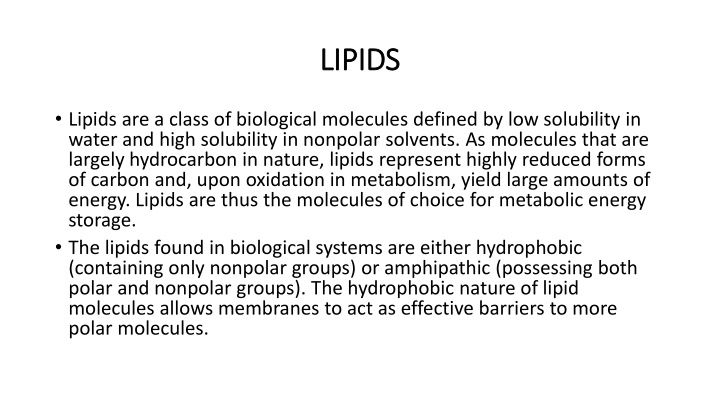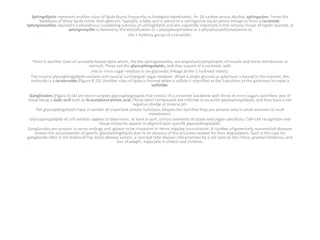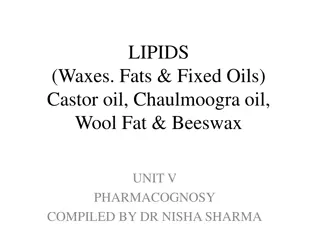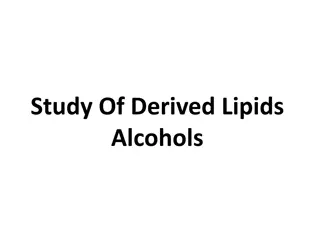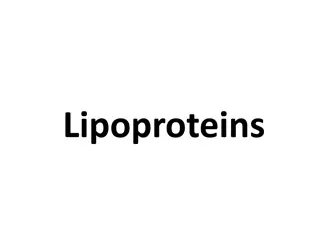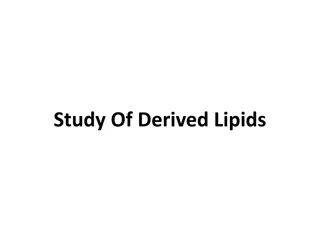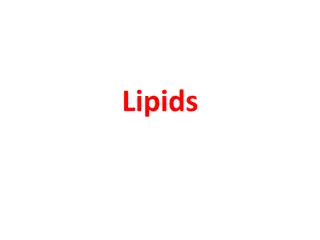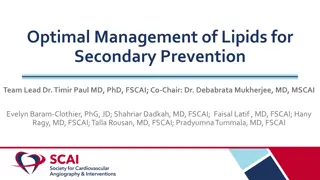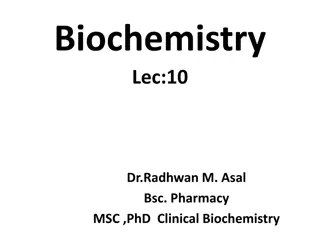LIPIDS LIPIDS
Lipids are essential biological molecules with diverse functions, serving as energy stores, structural components of membranes, enzyme cofactors, and more. Fatty acids, triglycerides, and other lipid types play crucial roles in metabolic processes and cellular function. Understanding the nature and functions of lipids is fundamental to studying biochemistry and physiology.
Download Presentation

Please find below an Image/Link to download the presentation.
The content on the website is provided AS IS for your information and personal use only. It may not be sold, licensed, or shared on other websites without obtaining consent from the author.If you encounter any issues during the download, it is possible that the publisher has removed the file from their server.
You are allowed to download the files provided on this website for personal or commercial use, subject to the condition that they are used lawfully. All files are the property of their respective owners.
The content on the website is provided AS IS for your information and personal use only. It may not be sold, licensed, or shared on other websites without obtaining consent from the author.
E N D
Presentation Transcript
LIPIDS LIPIDS Lipids are a class of biological molecules defined by low solubility in water and high solubility in nonpolar solvents. As molecules that are largely hydrocarbon in nature, lipids represent highly reduced forms of carbon and, upon oxidation in metabolism, yield large amounts of energy. Lipids are thus the molecules of choice for metabolic energy storage. The lipids found in biological systems are either hydrophobic (containing only nonpolar groups) or amphipathic (possessing both polar and nonpolar groups). The hydrophobic nature of lipid molecules allows membranes to act as effective barriers to more polar molecules.
Functions The biological functions of the lipids are as diverse as their chemistry. Fats and oils are the principal stored forms of energy in many organisms. Phospholipids and sterols are major structural elements of biological membranes. Other lipids, although present in relatively small quantities, play crucial roles as enzyme cofactors, electron carriers, light-absorbing pigments, hydrophobic anchors for proteins, chaperones to help membrane proteins fold, emulsifying agents in the digestive tract, hormones, and intracellular messengers.
Storage lipids The fats and oils used almost universally as stored forms of energy in living organisms are derivatives of fatty acids. The fatty acids are hydrocarbon derivatives, at about the same low oxidation state (that is, as highly reduced) as the hydrocarbons in fossil fuels. The cellular oxidation of fatty acids (to CO2 and H2O), like the controlled, rapid burning of fossil fuels in internal combustion engines, is highly exergonic. Two types of fatty acid containing compounds 1. Triacylglycerols 2. waxes
Fatty acid A fatty acid is composed of a long hydrocarbon chain ( tail ) and a terminal carboxyl group (or head ). The carboxyl group is normally ionized under physiological conditions. Fatty acids occur in large amounts in biological systems but only rarely in the free, uncomplexed state. They typically are esterified to glycerol or other backbone structures. Most of the fatty acids found in nature have an even number of carbon atoms (usually 14 to 24). Fatty acids are either saturated (all carbon carbon bonds are single bonds) or unsaturated (with one or more double bonds in the hydrocarbon chain). If a fatty acid has a single double bond, it is said to be monounsaturated, and if it has more than one, polyunsaturated.
Triacylglycerols The simplest lipids constructed from fatty acids are the triacylglycerols, also referred to as triglycerides, fats, or neutral fats. Triacylglycerols are composed of three fatty acids each in ester linkage with a single glycerol . Those containing the same kind of fatty acid in all three positions are called simple triacylglycerols and are named after the fatty acid they contain. Simple triacylglycerols of 16:0, 18:0, and 18:1, for example, are tripalmitin, tristearin, and triolein, respectively. Most naturally occurring triacylglycerols are mixed; they contain two or three different fatty acids. The name and position of each fatty acid must be specified polar hydroxyls of glycerol and the polar carboxylates of the fatty acids are bound in ester linkages, triacylglycerols are nonpolar, hydrophobic molecules, essentially insoluble in water
In most eukaryotic cells, triacylglycerols form a separate phase of microscopic, oily droplets in the aqueous cytosol, serving as depots of metabolic fuel. In vertebrates, specialized cells called adipocytes, or fat cells, store large amounts of triacylglycerols as fat droplets. Triacylglycerols are also stored as oils in the seeds of many types of plants, providing energy and biosynthetic precursors during seed germination . Adipocytes and germinating seeds contain lipases, enzymes that catalyze the hydrolysis of stored triacylglycerols, releasing fatty acids for export to sites where they are required as fuel.
Waxes Biological waxes are esters of long-chain (C14 to C36) saturated and unsaturated fatty acids with long-chain (C16 to C30) alcohols . Their melting points (60 to 100 8C) are generally higher than those of triacylglycerols. In plankton, the free-floating microorganisms at the bottom of the food chain for marine animals, waxes are the chief storage form of metabolic fuel. Waxes also serve a diversity of other functions related to their water-repellent properties and their firm consistency. Certain skin glands of vertebrates secrete waxes to protect hair and skin and keep it pliable, lubricated, and waterproof. Birds, particularly waterfowl, secrete waxes from their preen glands to keep their feathers water-repellent. The shiny leaves of holly, rhododendrons, poison ivy, and many tropical plants are coated with a thick layer of waxes, which prevents excessive evaporation of water and protects against parasites. Biological waxes find a variety of applications in the pharmaceutical, cosmetic, and other industries. Lanolin (from lamb s wool), beeswax , carnauba wax (from a Brazilian palm tree), and wax extracted from spermaceti oil (from whales) are widely used in the manufacture of lotions, ointments, and polishes.
Biological membranes is a double layer of lipids, which acts as a barrier to the passage of polar molecules and ions. Membrane lipids are amphipathic: one end of the molecule is hydrophobic, the other hydrophilic. Their hydrophobic interactions with each other and their hydrophilic interactions with water direct their packing into sheets called membrane bilayers
Glycerophospholipids Glycerophospholipids Lehninger Principles of Biochemistry, Nelson and Cox,
Membrane lipid found only in some archaea Lehninger Principles of Biochemistry, Nelson and Cox
Sphingolipids In humans, at least 60 different sphingolipids have been identified in cellular membranes. Most of them are especially prominent in the plasma membranes of neurons, and some are clearly recognition sites on the cell surface. The carbohydrate moieties of certain sphingolipids define the human blood groups and therefore determine the type of blood. Recognition for extracellular molecules or surfaces of neighboring cells
Sterols Sterols are structural lipids present in the membranes of most eukaryotic cells. The characteristic structure of this fifth group of membrane lipids is the steroid nucleus, consisting of four fused rings, three with six carbons and one with five The steroid nucleus is almost planar and is relatively rigid; the fused rings do not allow rotation about COC bonds. Cholesterol, the major sterol in animal tissues, is amphipathic, with a polar head group (the hydroxyl group at C-3) and a nonpolar hydrocarbon body (the steroid nucleus and the hydrocarbon side chain at C-17), about as long as a 16-carbon fatty acid in its extended form. Similar sterols are found in other eukaryotes: eg. stigmasterol in plants and ergosterol in fungi. Bacteria cannot synthesize sterols; a few bacterial species, however, incorporate exogenous sterols into their membranes.
Cholesterol Lehninger Principles of Biochemistry, Nelson and Cox,
Functions of lipids The two functional classes of lipids considered thus far (storage lipids and structural lipids) are major cellular components; membrane lipids make up 5% to 10% of the dry mass of most cells, and storage lipids more than 80% of the mass of an adipocyte. Lipids play a passive role in the cell, lipid fuels are stored until oxidized by enzymes, membrane lipids form impermeable barriers around cells and cellular compartments. Another group of lipids, present in much smaller amounts, have active roles in the metabolic traffic as metabolites and messengers. Some serve as potent signals as hormones, carried in the blood from one tissue to another, or as intracellular messengers generated in response to an extracellular signal (hormone or growth factor). Others function as enzyme cofactors in electron-transfer reactions in chloroplasts and mitochondria, or in the transfer of sugar moieties in a variety of glycosylation reactions. A third group consists of lipids with a system of conjugated double bonds: pigment molecules that absorb visible light. Some of these act as light-capturing pigments in vision and photosynthesis; others produce natural colorations, such as the orange of pumpkins and carrots and the yellow of canary feathers. A very large group of volatile lipids produced in plants serve as signals that pass through the air, allowing plants to communicate with each other, and to invite animal friends and foes.
References- Lehninger Principles of Biochemistry, Nelson and Cox, Macmillan Higher education Biochemistry.R.H.Garrett and C.J.Grisham Nelson Education ltd. Biochemistry Voet and Voet
